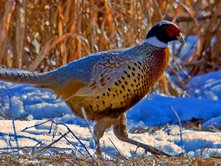By Rachael Gleason
rachaelkaygleason@gmail.com
Great Lakes Echo
Sept. 22, 2009
Lousy weather and increased farming mean fewer pheasants in Minnesota grasslands this year.
The Minnesota Department of Natural Resources reports a 27 percent decline in the pheasant population from last year. The number of birds also fell below the 10-year average.

photo by Hvrgas
A harsh winter and a cool, wet spring made it hard for baby pheasants to survive, said Dennis Simon, a wildlife chief at the state agency.
“We finally had a normal winter and there was a loss of birds,” Simon said.
At the same time more than 100,000 acres in a federal conservation program were converted to farmland last year, he said. That made it hard for the birds to find places to nest. The Conservation Reserve Program protects grasslands through farmland retirement. But as contracts with landowners mature, Simon said habitat for pheasants and other waterfowl is lost.
“We’re seeing a lot of land lost to the conversion of pasture into corn and soybean fields,” he said.
The state agency expects an additional 63,000 acres in the program revert to farmland to by the end of the month.
South Dakota and other states in the Northwest are experiencing similar problems with birds, Simon said.
Still, the pheasant population in Minnesota’s eastern neighbor is thriving.
That state has had mild winters and decent springs, said Kyle Anderson, a wildlife technician for the Wisconsin Department of Natural Resources.
Habitat for the brightly colored bird is also increasing.
“Some old fields have been converted into grasslands,” Anderson said. “That’s definitely helped.”
Pheasant hunting in Minnesota starts in mid-October. The state estimates the fall population will mirror 2004 figures when approximately 420,000 roosters were harvested.
The sport won’t harm reproduction, Simon said. If the pheasant population becomes too low, hunters simply quit hunting.
“It’s a self limiting thing,” he said.
To slow a shrinking pheasant population in the long-term more land must be put into conservation programs, Simon said.